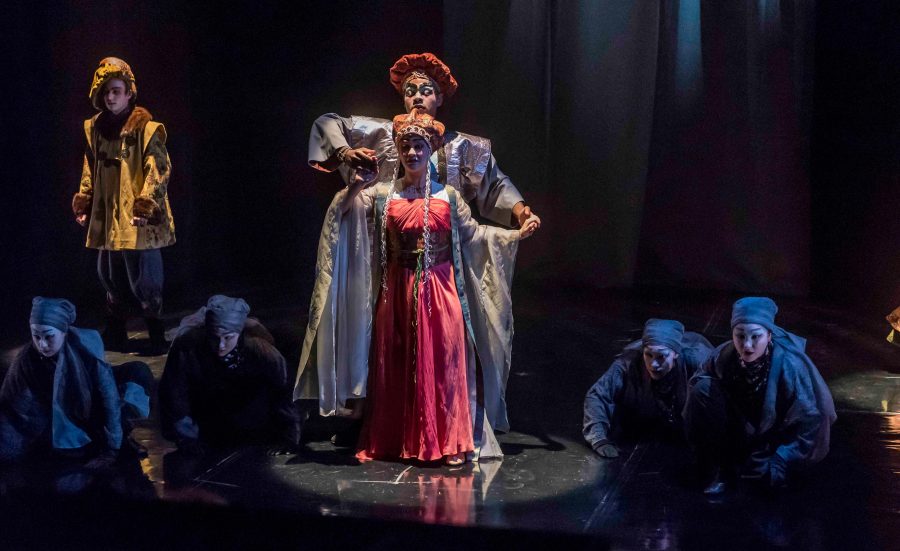“Iago’s Plot” combines traditional Japanese theater and Shakespeare
Photo Courtesy of Darrell Hoemann
From left: Brabantion/Venetian Ambassador played by Joe Agase, Desdemona played by Elana Weiner-Kaplow, and Othello played by Christian Wilson during a rehearsal of Iago’s Plot in the Studio Theatre at Krannert Center in Urbana on Tuesday, March 28, 2017.
April 4, 2017
At some time in their academic career, most University students have read or seen a Shakespeare play. The Krannert Center’s latest production looks at Shakespeare in an unconventional way by mixing traditional Japanese theater with Shakespeare’s famous play “Othello.”
Although this blend does not necessarily ring true in the eyes of traditional Shakespearean plays, University faculty member Shozo Sato created a way to pull it off.
“Iago’s Plot” is an original production of “Othello” created and directed by Sato.
The show’s uniqueness comes from Sato’s background in Zen arts. He was able to blend Western theater techniques with Japanese ones in order to create his own distinctive style for “Iago’s Plot,” in addition to his other Kabuki plays.
Bridget Lee-Calfas, Krannert advertising and publicity director, wrote in an email that Sato has been involved with the Krannert Center ever since its establishment in the 1960s. She said Sato’s involvement with Krannert, theater and the Japan House have come together in this play.
Get The Daily Illini in your inbox!
“This production, ‘Iago’s Plot,’ was last performed in the 1990s so it will be an opportunity for a new generation to experience his interpretation of Othello,” Calfas wrote.
“Iago’s Plot” is not just being performed at the University. Sato’s creation has come to life on stages from Baltimore, Md. to Egypt and even Germany.
Traditionally, Kabuki is a style of Japanese performance that combines song, dance and elaborate costumes and stages. In traditional forms of Kabuki, men were the only ones with roles. Training for actors began at a very young age, and it was extremely rigorous and cultural in Japanese performances.
Jessica Kadish, graduate student in FAA, plays the role of Emilia in “Iago’s Plot.” She said that she and many of the other actors had little Kabuki background. Sato taught the actors everything they needed to know to successfully embody the characters.
“Luckily for us, our director, Shozo Sato, has spent his entire life helping students to access this form, using his artistic and cultural expertise and guidance to blend elements of Kabuki style with American and European performance styles,” Kadish said.
Robin McFarquhar, stage combat director, was a valuable part in making this production of “Iago’s Plot” possible and pushing the production to happen. He said working with Sato is a valuable experience for students.
The invaluable nature of working in different performance styles can prove challenging not only for actors but for everyone involved in the production.
McFarquhar said he has done fight directing for other Kabuki-style productions of Sato’s, but that each production had a different approach than required for normal plays.
“When I am working in a Kabuki style, I am allowing the audience to use their imaginations much more,” McFarquhar said. “So I am creating something that is highly stylized that would never work in reality but allows the audience to engage their imaginations and create their own story of the fights.”
The Kabuki style of performance is not the only different aspect in this “Othello” rendition. Sato edited the storyline to largely focus on Iago’s character. Sato placed emphasis on Iago’s jealousy and attempts to ruin Othello. The ending to “Iago’s Plot“ is different than the original play.
Kadish said “Iago’s Plot“ is not like any other production she’s been involved with before. Even though it is different from the original “Othello,” the show has been received warmly thus far by audiences.
“They say it’s visually stunning, tragic and haunting. Many of our friends have told us they didn’t recognize us when they saw us onstage at first because we look, move and sound so different,” Kadish said.
Audiences can continue to enjoy “Iago’s Plot” in the Krannert Center through April 9. The unique Kabuki style of this production lends itself to an artistic experience encompassing the costumes, acting techniques and overall themes of the show.
The actors in the show have each worked to gain an understanding and appreciation of Kabuki Japanese style by working with Sato throughout the entire production process.
“It’s extremely humbling, challenging, rewarding and a completely unique artistic opportunity,” Kadish said.







